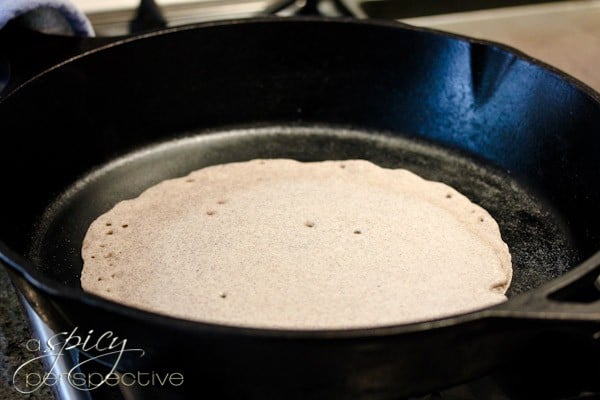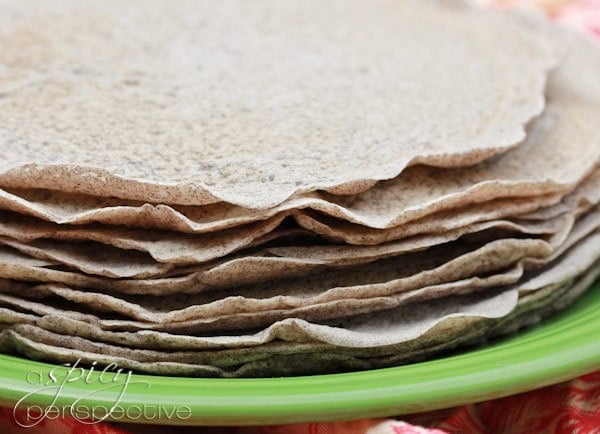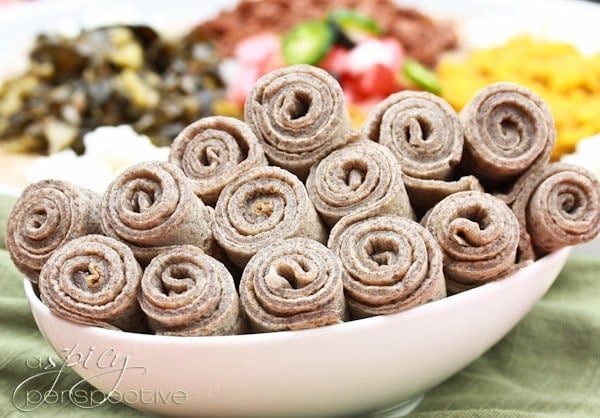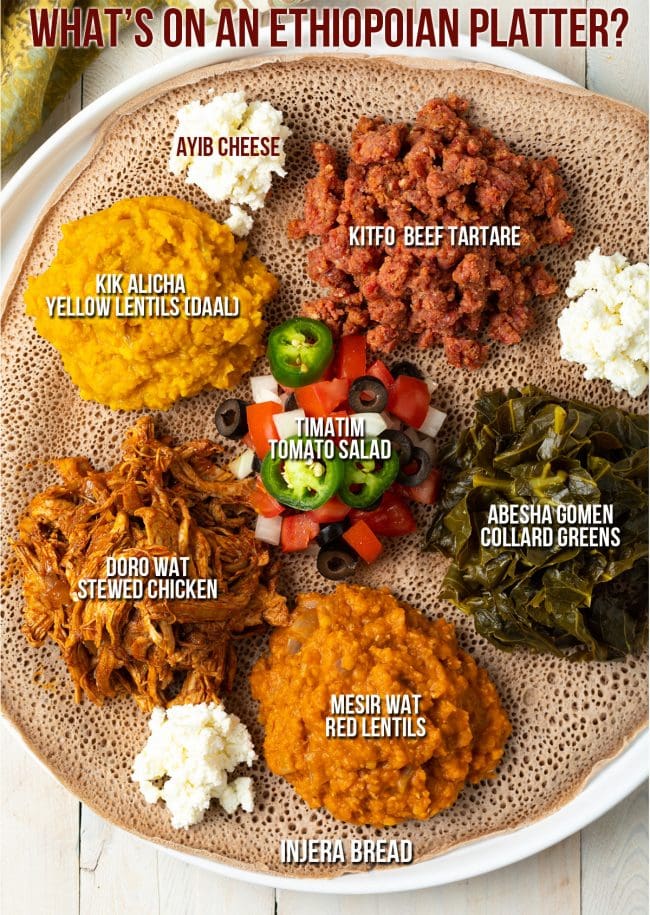Ethiopian Bread
This Ethiopian Bread recipe is a quick and easy take on the traditional Injera and features a sourdough crepe-like flatbread that you can make at home!


Sommer’s Recipe Notes
Several major American cities have large Ethiopian populations with amazing restaurants and markets throughout. Washington D.C., New York, Chicago, Atlanta, and Dallas are among the largest. And every time we visit family in Dallas, we always eat delicious Injera bread at our favorite Ethiopian restaurant.
Ethiopian Breaad, known as Injera, is a staple Ethiopian dish that you definitely need to learn how to make at home! This sourdough flatbread is always paired with other dishes to soak up the saucy meats, veggies and beans that it accompanies.
Why You’ll Love Ethiopian Bread
- Wonderful texture – This soft and spongy traditional Ethiopian bread is great for scooping up big chunks of stews.
- Diet-friendly – Injera is naturally dairy-free and egg-free!
- Make-ahead hero – Make big batches of this flatbread recipe and store it in the freezer for future use.
Our Easy Ethiopian Bread is not only quick and easy to make in any nonstick skillet, but it’s also tender, rollable, and undoubtedly sour… With absolutely no wait time.

Ingredients and Tips
- All-purpose flour – Use traditional flour to make the sourdough crepes soft and pliable.
- Buckwheat flour – For that pop of color and soft, spongy texture use buckwheat flour.
- Baking Soda – Baking soda will give light air bubbles.
- Club Soda – Club soda will also help to create the bubbly texture.
- Vinegar – Use a good quality vinegar to create the fermented sour taste.
Recipe Variations and Dietary Swaps
- Lemon juice – Swap vinegar with lemon juice for a similar flavor.
- Spices – Add cumin or coriander for an aromatic twist.
- Gluten-free – Use gluten-free all-purpose flour.
- Teff flour – To make a traditional Injera, swap both the all-purpose flour and buckwheat flour with teff flour Just keep in mind that teff flour is hard to find.

How To Make Ethiopian Bread
Injera at Ethiopian restaurants is made as large pizza-sized circular crepes. At home, you can make it in any good nonstick skillet you have available. Just mix the ingredients for the batter, cook it up and then roll the crepes into your final dish!
Find the full Ethiopian Bread recipe with detailed instructions and storage tips in the printable form at the bottom of the post!



Storage Notes
- Storing Leftovers – Store leftover Ethiopian bread in an airtight container and in the refrigerator for up to 3 days.
- Freezing Leftovers – Place cooked Injera stacked on top of one another between parchment paper. Wrap it tightly in plastic wrap and freeze for 2 months.
- Reheating Leftovers – I recommend warming these up in the oven.
Serving Suggestions
Ethiopian “Queen” Platters are a great idea for your adventurous dinner guest’s menu. There’s nothing like sitting around a large colorful platter of exotic dishes, scooping them up with your hands. Oh, the memories you will make!
Serve fresh-made Injera Bread with any of the below Ethiopian stews!
- Chicken Doro Wat (a chicken stew made in the slow cooker)
- Kitfo Ethiopian Beef Tartare or Tere Siga (minced raw meat)
- Mesir Wat Red Lentil Stew
- Ayib Cheese
- Yellow Peas like Daal
- Collards or other wilted greens (Gomen)
- Tomato Salad if you like.
- Smeared with Niter Kibbeh (a spiced clarified butter)
- Fenugreek Stew by Eat Smarter
Most of these dishes can be made ahead of time if needed.
(PS, the links to yellow peas and collards aren’t technically Ethiopian recipes, but they are similar and VERY delicious!)

Ethiopian Injera Bread
Video
Ingredients
- 3 cups all purpose flour
- 1 cup buckwheat flour
- 2 tablespoons baking soda
- 1 teaspoon salt
- 4 cups club soda
- 1 cup white vinegar or rice vinegar
- Oil for pan
Instructions
- In a large bowl, mix both flours, salt, and baking soda together. Whisk in the club soda until smooth. Then add the vinegar and whisk.
- Heat a large nonstick skillet over medium heat. Pour oil on a paper towel and wipe the skillet with the oiled paper towel. This creates a thin fatty layer to make it easier to flip the crepes.
- Using a scoop, pour batter into the skillet creating a 6-inch circle. Quickly and carefully swirl the pan around to thin out the batter until it measures 8- to 9-inches across.
- Cook for 1 minute, then using a large spatula, flip the Injera over and cook another minute. Remove from the skillet and stack on a plate. Repeat with remaining batter. The Injera will seem slightly crisp in the pan, but will soften immediately when placed on the plate. The stacking also helps steam and soften the Injera sourdough crepes.
Notes
Nutrition

Frequently Asked Questions
Teff flour is the flour most commonly used in the traditional Ethiopian Injera recipe. It is light and naturally gluten-free, but not always easy to find. If you do find it, you can use it in this recipe in place of the all-purpose flour and buckwheat flour, 4 cups total to make an amazing Injera batter.
You might have overcooked the bread or stacked it in the wrong way. Make sure to reduce the cooking time then, and stack them up immediately after flipping them!
There are some non-traditional Ethiopian dishes you can pair with this bread which can include vegetables (like green beans, cabbage, potatoes, or carrots). You can focus this platter on a vegan-style dish, or vegetarian dish with more grains, porridge, and chickpeas rather than meats. You could even serve it alongside your favorite fruits, like mango or papaya.







Those crepes look so delicate and healthy..need to give a try.
WOWSER!! What a tempting and delicious feasts! I’ve never sample ethiopian foods before. Can’t wait to try it soon :)
I find Ethiopian cuisine fascinating. Wish we had a restaurant nearby so I could try it. Thanks for sharing your recipes so I can try it at home.
i lived in addis ababa as a kid and i adore ethiopian cuisine. living in baltimore, i am very pleased to say that there are TWO great ethiopian restaurants i can hit up when i have a craving.
i’d love to attempt an actual feast but the fact that there are so many side dishes to make for just one meal, plus the actual injera makes it hard to be motivated to make all them…
your pix are gorgeous, sometimes it’s hard to take shots of ethnic foods appetizingly.
I love the idea of having a dinner party where everyone eats with their hands!
Oh wow oh wow that rolled up injera is so beautiful! As is that platter… I cannot wait to make this!
Sommer-
Thanks for sharing this. There used to be an Ethiopian restaurant in Miami but it went out of business and I’ve been wanting to try for a while. I’m going to give this a shot!!
no earthly idea what kind of market ethiopian market denver has … at least, in comparison to the bigger cities you mentioned. i know of a couple of restaurants, and they’re not bad, but need to spend more time checking them out. cheers!
I’ve been falling in love with Ethiopian food lately. We have a restaurant down the street, and I love going!
OMG! This looks so good. I lived in DC or 6 years and survived on Ethiopian food. It’s really the best cuisine – flavorful, rich, very comforting, and healthy. You are making me hungry!
Totally wishing we had some Ethopian restaurants nearby….chicken looks fabulous! I’ve printed out your Mesir Wat recipe & will be making it soon!
Love the quick “injera” – you are right, planning 3 days ahead of time is not usually happening in our house either…